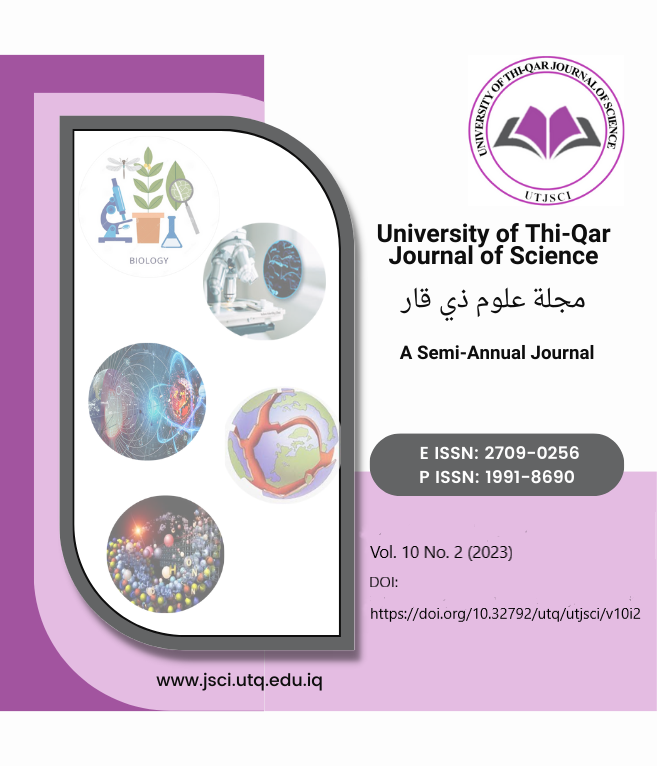Analysis and evaluation of sediment pollutants of Euphrates River at Al-Nasiriyah city, south of Iraq
DOI:
https://doi.org/10.32792/utq/utjsci/v10i2.1110Keywords:
Euphrates River; Sediment pollutants; Water period.Abstract
In this work, total phosphorus (TP), total nitrogen (TN) and organic matter (OM) were detected in the sediment of Euphrates River in different period’s time. Then we did the analysis and the characterization of these pollutants for this river. In addition, . The findings of this study showed that the sediment levels of total phosphorus in Euphrates river were 2.05 ~ 6.50 mg/g, 1.65 ~ 3.17 mg/g and 0.71 ~ 0.93 mg/g the sediment levels of total nitrogen were 5.06 ~ 8.98 mg/g, 6.07 ~ 8.56 mg/g and 5.02 ~ 7.99 mg/g. Also, organic matter levels in sediment were 40.54 ~ 70.1 mg/g, 58.70 ~ 85.63 mg/g and 11.32 ~ 30.17 mg/g in Clearly, from that analysis and comparison of pollutants level, the sediment of Euphrates River is the main source of contamination. This may be able to result from increasing the human activities and the increment of industrial actions in this region.
Received: 2023-08-24
Revised: 2023-09-17
Accepted: 2023-09-22
References
- O. Hutzinger, “The Chemistry of PCB'S: 0. CRC press”. (2018).
- A.Nur, “Rainy Season, G. Fills Jatigede Reservoir,S”.DetikNews.https://news.detik.com/foto-news/d-5856374/musim-hujan-sampah-penuhi-waduk-jatigede-sumedang. 2021.
- WHO (World Health Organization ). “Guidelines for drinking-water”. (2006).
- A. Kazem Abdul-ameer Muhsin. “Contamination of water ecosystems in Iraq and future challenges”. Journal of Faculty of Yarmouk University, 8 (1), 72-94 (2016).
- F. Polat, Akın, Ş., Yıldırım, A., & Dal, T. “The effects of point pollutants-originated heavy metals (lead, copper, iron, and cadmium) on fish living in Yeşilırmak River, Turkey”. Toxicology and industrial health, 32(8), 1438-1449 (2016).
- T. Beer, “Environmental oceanography. CRC Press”. (2017).
- MK. Wardhani, “Dynamic Model of Nutrient Concentration in Estuarine Waters”. Prosiding Seminar Nasional Jilid 3, 1038–1044( 2016).
- H. Meirinawati ,“Phosphorus cycle in the ocean”. Jurnal Oseana ,40: 31–40 (2015).
- S. B. Sharhan , B. Yossif Al- khafaji, A. S. Al-ashoor , “Evaluation of organic and microbial contamination in the sediments of Euphrates river at the center of Al- Nasiriya city , south of Iraq” . Journal of Education for Pure Science –University of Thi-Qar , 9(2) (2019) .
- S. Awad Turki , A. Abid Maktoof , “Assessment of water quality for Euphrates river in Al-Nasiriyah city by using organic pollution index” , Journal of Education for Pure Science –University of Thi-Qar ,9(2) (2019) .
- Chinese, NEPA , Water and Wastewater Monitoring Methods (fourth edition) 2002 [M]. China Environmental Science Press..
- Bao, S.D. Soil agricultural chemical analysis. (3rd Edition) , China Agricultural Press 2000 [M]. China Agricultural Science and Technology Publishing House.
- M. Hazem Mohammed . “The impact of water quality on the Tigris River and the initial treatment of the Tigris River”, 17 (3): - 27 (2009).
- J. Caperon wayne ,A.H.,and frances ,A. “S PARTICULATE organic carbon ,nitrogen and chlorophyll as measures of phytoplankton in Kaneohe bay oahu” .pacific science ,30(4);317-327 (1976).
- M. Leivuori, NiemistOL, “Sedimentation of trace metals in the Gulf of Bothnia” [J]. Chemosphere, 31(8): 3839-3856 (1995).
- HJ/T2.1-93. “Master of Environmental Impact Assessment Guidelines” [S].
- S. EK, Wijaya OE. “Determination of water quality status with pollution index method and pollution control strategy of Ogan River, Ogan Komering Ulu Regency”. Journal Ilmu Lingkungan,17: 486–491(2019).
- HJ/T166-2004.“SoilEnvironmental Monitoring Technical Specifications” [S].
- P. Menteri Lingkungan Hidup Nomor 115 Tahun 2003 Tentang Pedoman Penentuan Status Mutu Air. 2003.
Downloads
Published
License
Copyright (c) 2023 University of Thi-Qar Journal of Science

This work is licensed under a Creative Commons Attribution 4.0 International License.













